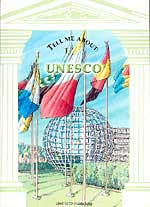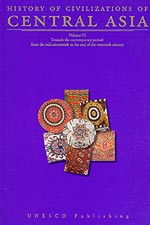AU’s goal, in collaboration with the U.S. National Commission, is to make U.S. participation broad-based, vital, and better understood.........AU board member Frank Method recently put it this way: “The U.S. today has its second chance to become a part of UNESCO; it if fails, there will be no third.”
Tuesday, August 22, 2006
UNESCO and the College Art Association: A Natural Partnership
UNESCO and the College Art Association: A Natural Partnership
AU’s goal, in collaboration with the U.S. National Commission, is to make U.S. participation broad-based, vital, and better understood.........AU board member Frank Method recently put it this way: “The U.S. today has its second chance to become a part of UNESCO; it if fails, there will be no third.”
DISCOVERING THE WORLD
Here are some of the titles:

"Tell me about UNESCO"
All about UNESCO for the young (10-12 years old): its history, functioning, ideals, programmes and buildings. A clear and well-documented overview of the Organization working towards a better understanding of tolerance.
"Tell me about World Heritage"
This compact guide promotes the understanding of what it means to be included on the World Heritage List. Written in an accessible way and illustrated with many examples, the book touches on the meaning of heritage, the World Heritage Convention, the criteria for choosing sites and their protection. In short, information and projects that bring alive the meaning of heritage for a young audience.
"Cultures and Civilizations"
The history of humankind, its cultures and civilizations, is inextricably linked with the development of trade. Cities grew up around the markets and empires were built on the wealth that trade created. Across Asia, the paths of the Silk and Spice Routes brought together many different peoples, fostering the exchange of ideas, lifestyles, arts and goods. This book explores exciting aspects of intercultural relations brought about by the thriving trade along the Silk and Spice Routes.
"Inventions and Trade"
Over the centuries, the exchange of technologies -from the horse's bit and the wheel to the microchip and the computer- hasinspired new developments and improvements. It is through trade that much of this exchange has taken place. This book explains how the Silk and Spice Routes across Asia played an important role in bringing together different peoples and ideas that favoured new technologies and inventions in many fields: health and medicine, alchemy and chemistry, astronomy, mathematics, spinning and weaving. glass and ceramics, metalwork and agriculture, to mention just a few.
"Exploration by Land"
A fascinating account of the life and adventures, the discoveries and explorations of travellers along the Silk Routes, stretching over 8,000 kilometres through the heart of Asia, from the Mediterranean to the China Sea. They crossed some of the most spectacular and dangerous places on Earth: the Pamir Mountains, the Hindu Kush and the notorius Taklamakan desert whose shifting sands have been known to swallow up great cities.
"Exploration by Sea"
An exciting description of the adventures and discoveries of travellers along the Spice Routes, which stretched for over 15,000 kilometres around Asia, from China's seas, across the Indian Ocean up the Red Sea and the Persian Gulf and overland to the Mediterranean. A dangerous route, full of treacherous coral reefs, violent storms and unexpected pirate attack, which nevertheless tempted many sailors and adventurers seeking trade or treasure over the ages.
DISCOVERING THE WORLD
Here are some of the titles:

"Tell me about UNESCO"
All about UNESCO for the young (10-12 years old): its history, functioning, ideals, programmes and buildings. A clear and well-documented overview of the Organization working towards a better understanding of tolerance.
"Tell me about World Heritage"
This compact guide promotes the understanding of what it means to be included on the World Heritage List. Written in an accessible way and illustrated with many examples, the book touches on the meaning of heritage, the World Heritage Convention, the criteria for choosing sites and their protection. In short, information and projects that bring alive the meaning of heritage for a young audience.
"Cultures and Civilizations"
The history of humankind, its cultures and civilizations, is inextricably linked with the development of trade. Cities grew up around the markets and empires were built on the wealth that trade created. Across Asia, the paths of the Silk and Spice Routes brought together many different peoples, fostering the exchange of ideas, lifestyles, arts and goods. This book explores exciting aspects of intercultural relations brought about by the thriving trade along the Silk and Spice Routes.
"Inventions and Trade"
Over the centuries, the exchange of technologies -from the horse's bit and the wheel to the microchip and the computer- hasinspired new developments and improvements. It is through trade that much of this exchange has taken place. This book explains how the Silk and Spice Routes across Asia played an important role in bringing together different peoples and ideas that favoured new technologies and inventions in many fields: health and medicine, alchemy and chemistry, astronomy, mathematics, spinning and weaving. glass and ceramics, metalwork and agriculture, to mention just a few.
"Exploration by Land"
A fascinating account of the life and adventures, the discoveries and explorations of travellers along the Silk Routes, stretching over 8,000 kilometres through the heart of Asia, from the Mediterranean to the China Sea. They crossed some of the most spectacular and dangerous places on Earth: the Pamir Mountains, the Hindu Kush and the notorius Taklamakan desert whose shifting sands have been known to swallow up great cities.
"Exploration by Sea"
An exciting description of the adventures and discoveries of travellers along the Spice Routes, which stretched for over 15,000 kilometres around Asia, from China's seas, across the Indian Ocean up the Red Sea and the Persian Gulf and overland to the Mediterranean. A dangerous route, full of treacherous coral reefs, violent storms and unexpected pirate attack, which nevertheless tempted many sailors and adventurers seeking trade or treasure over the ages.
The History of the Civilizations of Central Asia

UNESCO plays a valuable role in promoting and publishing serious historical studies. Click here to see a list of available historical publications from UNESCO Publishing. Especially noteworthy is the series on Civilizations of Central Asia, since this is an area of considerable current and historical interest, about which relatively little has been written.
Readers will discover through this six-volume work cultures that flourished and vanished from the dawn of civilization to the present time and how the history of the ancient and medieval world was shaped by the movements of peoples in this heartland of Eurasia, stretching from the Caspian Sea to the borders of China.
* Volume V: Development in Contrast: from the Sixteenth to the Mid-nineteenth Century
* Volume VI: Towards the Contemporary Period: From the Mid-nineteenth to the End of the Twentieth Century* # Part One: The Historical, Social and Economic Setting* Volume III: The Crossroads of Civilization: A.D. 250 to 750
* Part Two: The Achievements
* Volume II: The Development of Sedentary and Nomadic Civilizations: 700 B.C. to A.D. 250
* Volume I: The Dawn of Civilization: Earliest Times to 700 B.C.
The History of the Civilizations of Central Asia

UNESCO plays a valuable role in promoting and publishing serious historical studies. Click here to see a list of available historical publications from UNESCO Publishing. Especially noteworthy is the series on Civilizations of Central Asia, since this is an area of considerable current and historical interest, about which relatively little has been written.
Readers will discover through this six-volume work cultures that flourished and vanished from the dawn of civilization to the present time and how the history of the ancient and medieval world was shaped by the movements of peoples in this heartland of Eurasia, stretching from the Caspian Sea to the borders of China.
* Volume V: Development in Contrast: from the Sixteenth to the Mid-nineteenth Century
* Volume VI: Towards the Contemporary Period: From the Mid-nineteenth to the End of the Twentieth Century* # Part One: The Historical, Social and Economic Setting* Volume III: The Crossroads of Civilization: A.D. 250 to 750
* Part Two: The Achievements
* Volume II: The Development of Sedentary and Nomadic Civilizations: 700 B.C. to A.D. 250
* Volume I: The Dawn of Civilization: Earliest Times to 700 B.C.
UNESCO plans assistance in Lebanon's early recovery efforts
One week after a cease-fire between Israel and Hizbollah went into effect, four experts from the UN Educational, Scientific and Cultural Organization (UNESCO) arrived yesterday in Lebanon for a five-day mission to determine how the cultural agency can best help the country recover from the devastation caused by the conflict.
The Lebanese government-led early recovery plan will be presented to an international donors’ conference for Lebanon in Sweden on 31 August.
UNESCO plans assistance in Lebanon's early recovery efforts
One week after a cease-fire between Israel and Hizbollah went into effect, four experts from the UN Educational, Scientific and Cultural Organization (UNESCO) arrived yesterday in Lebanon for a five-day mission to determine how the cultural agency can best help the country recover from the devastation caused by the conflict.
The Lebanese government-led early recovery plan will be presented to an international donors’ conference for Lebanon in Sweden on 31 August.
UNESCO's Interreligious Dialogue
The UNESCO program is complementary to the World Faiths Development Dialogue that was set up in 1998 as an initiative of James D. Wolfensohn, President of the World Bank and Lord Carey, then Archbishop of Canterbury. The aim of the WFDD is to facilitate a dialogue on poverty and development among people from different religions and between them and the international development institutions.
Check out:
* The Network of UNESCO Chairs on the Intercultural and Interreligious Dialogue
* UNESCO's Effort to Promote Intercultural Dialogue in Central Asia
* UNESCO's International Congress on Dialogue of Civilizations, Religions and Cultures in West Africa
UNESCO's Interreligious Dialogue
The UNESCO program is complementary to the World Faiths Development Dialogue that was set up in 1998 as an initiative of James D. Wolfensohn, President of the World Bank and Lord Carey, then Archbishop of Canterbury. The aim of the WFDD is to facilitate a dialogue on poverty and development among people from different religions and between them and the international development institutions.
Check out:
* The Network of UNESCO Chairs on the Intercultural and Interreligious Dialogue
* UNESCO's Effort to Promote Intercultural Dialogue in Central Asia
* UNESCO's International Congress on Dialogue of Civilizations, Religions and Cultures in West Africa